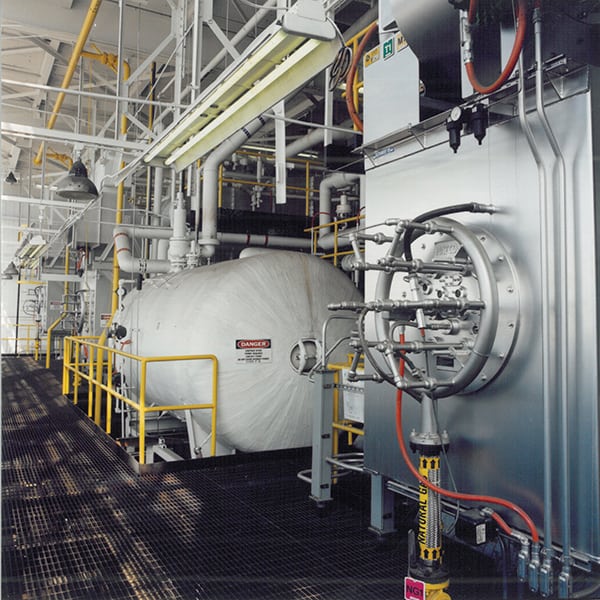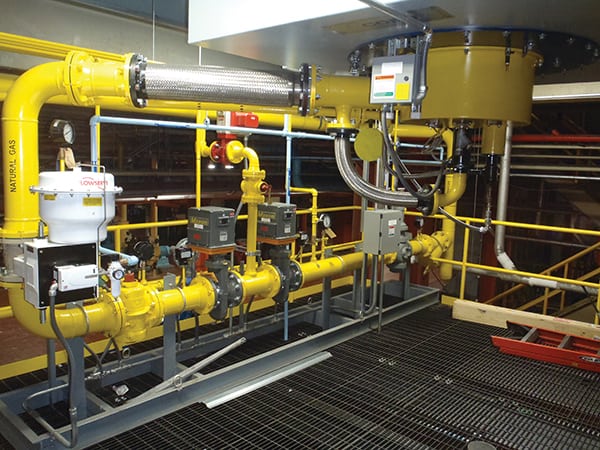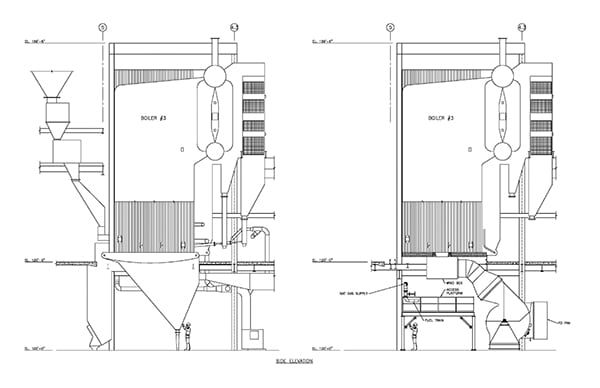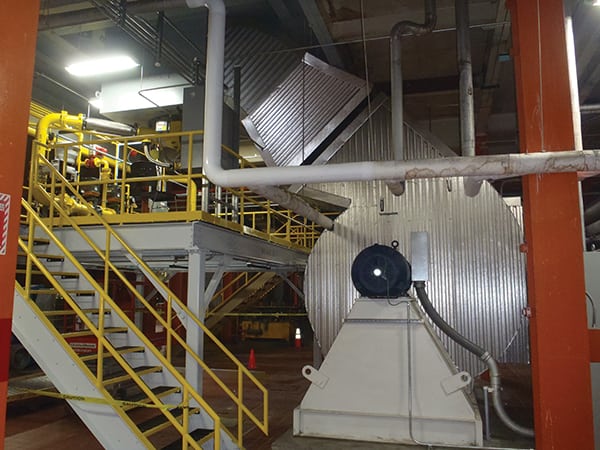Practical Considerations for Converting Industrial Coal Boilers to Natural Gas
Increasing Environmental Protection Agency (EPA) restrictions pertaining to emissions from coal-fired power plants, the increasing cost of coal operations, and the decreasing cost of natural gas provide strong arguments for converting coal-fired boilers to natural gas–firing ones. Coal-fired boilers have emissions that are potentially noncompliant with the Maximum Achievable Control Technologies (MACT) rule and Mercury and Air Toxics Standards (MATS), which will require modifications to most coal-firing systems.
Where should coal boiler owners start when evaluating the various conversion options for their facilities? A comprehensive understanding of various design alternatives and their implications is crucial to optimizing the initial capital cost, operating cost, safety, and reliability of the facility.
Conversion Benefits
The primary benefits of converting a coal boiler to fire natural gas are a more cost-effective, cleaner, more efficient, and reliable source of steam. As compared with installing a new boiler, converting an operational coal-fired unit to natural gas typically requires a lower capital investment, enables the most condensed schedule, and makes use of the existing asset.
Although the solution is not new (see “Natural Gas Conversions of Existing Coal-Fired Boilers” in the August 2011 issue of POWER) and has been covered recently in two Special Report articles (see “Practical Considerations for Converting Boilers to Burn Gas” and “Utility Options for Leveraging Natural Gas” in the October 2013 issue of POWER), the topic continues to be relevant due to evolving EPA regulations and public perceptions of climate change initiatives.
For most industrial boiler owners, re-utilization of the existing asset is the most desirable course of action. Converting an existing boiler is typically 15% to 30% of the cost of installing a new natural gas boiler. Additionally, converting coal boilers to firing natural gas provides the following major benefits.
Cleaner Operation. Natural gas burns cleaner than coal, because it does not contain significant amounts of sulfur, atomic nitrogen, particulate, or ash. Additionally, natural gas allows for more precombustion controllability for lower emissions, such as NOX and CO, without the need for extensive flue gas treatment equipment.
Operating Cost Savings. For several years the cost of natural gas has been decreasing while the cost of coal has been increasing. By using only natural gas instead of coal, facilities can eliminate operations, maintenance, and environmental costs associated with coal/ash storage and handling. With no ash carryover, natural gas avoids ash buildup, which reduces heat transfer, meaning the boiler can maintain its efficiency.
Increased Boiler Flexibility. Converting to natural gas improves boiler flexibility and turndown capability. Coal-fired boilers do not react to sudden load swings as effectively as a converted natural gas boiler. Further, coal-fired boilers have a limited turndown capability, thus limiting their effectiveness during low steam demand. Bringing a coal-fired boiler back online after a shutdown requires much more time than is required by a natural gas boiler.
Determining Emissions Limitations Is the Key First Step
So you have a coal boiler that appears to be a perfect candidate for conversion. Where do you start? CO and NOX emissions limitations are of primary importance when converting boilers to natural gas-firing. These emission limitations dictate the requirements of the burner design, air/fuel mixing technology, and resulting flame temperature. Emission limitations affect combustion airflow requirements, refractory requirements, amount of flue gas recirculation, duct sizing, and damper control, all of which have an effect on the forced draft (FD) fan and induced draft (ID) fan requirements.
Getting too far along in the design of the project and then finding that the emissions limitations have changed could mean starting from scratch with a new design. Working with a qualified environmental consulting firm is a great way to make sure that the project is getting started on the right track.
Vertical or Horizontal Firing?
There are two typical arrangements for mounting the most important part of the conversion—the burners: horizontal, wall-mounted burner design and vertical, upward-mounted burner design. For both arrangements, the following considerations are important.
Heat Input Required. How many Btu of natural gas must be burned to achieve the operational steam output at the required pressure and temperature?
Boiler Furnace Geometry. Furnace dimensions significantly affect the burner design and burner placement. If the boiler has superheater tubes in the radiant area, the distance from the grate to the lowest part of the superheater tubes is also critical to the design.
Backend Modifications Needed. Does a baghouse or other flue gas equipment need to be bypassed or removed? Does a cyclone separator need to be “gutted” to reduce the flue gas pressure drop, or is the ID fan so oversized that additional flow restrictions are needed to utilize the fan? A cost-benefit analysis of replacing the ID fan versus installing flow restrictions may be advised. Installing a variable frequency drive (VFD) for the ID fan may also make sense.
Impact of the Conversion on the Boiler. Depending on burner placement, a conversion from coal to gas changes the energy release slightly. Natural gas flames produce lower radiational energy, thus radiant heat transfer in the lower furnace is less, while the convective heat transfer is increased through the backpass/economizer.
On the steam side, the changes in combustion temperature, quantity, and composition affect the velocities and heat absorption within the furnace, economizer, and superheater sections and thus has an effect on steam flow and temperature. A boiler impact study may be needed to evaluate the gas and steam processes that may be affected by the conversion. This analysis can provide an impact evaluation of boiler emissions, heat transfer, boiler efficiency, steam production, and steam temperature.
Natural Gas Flow and Pressure Availability. A new main gas line or a pressure regulation station with a new tap into an existing main gas line may be needed.
Electrical Distribution System Capacity. Does the current system have the necessary capacity available for the project?
Existing Boiler Condition. Is the boiler clean and in good repair? Is retubing or similar work needed?
Code Requirements. Boiler code requirements differ in some areas for natural gas versus coal-fired boilers. This may require boiler safety relief valve (SRV) replacement or recertification, boiler feedwater delivery pressure and flow capacity changes in relation to boiler maximum pressure and SRV settings, as well as other relevant ASME code–dictated work.
Wall-Mount Burner Conversion Considerations
In a wall-mount arrangement, the burner or burners are mounted within either the front wall, side wall, or rear wall (Figure 1). Each potential burner location must be evaluated for a number of concerns:
- What is the distance to the opposing wall, thus what is the distance the flame can occupy without impinging on the opposite wall? This will help in determining the number of burners and burner design required to deliver the required heat input while avoiding flame impingement.
- Are water wall tubes currently in the way of where the burners should be mounted? If so, new bent tube panels would need to be installed to accommodate the throats of the burners, thus requiring engineering design of the panels, shop fabrication, and field labor to cut out the existing straight tubes and weld in the new sections.
- What is the front header clearance? If the burners are to be mounted in the front wall, then the front header height becomes an important element. Depending upon the header height from the floor, the burners and windboxes may have to be located between this header and the operating floor. Low clearance may also dictate multiple smaller burners, extensive relocation costs for the header, or modifications to the floor.
 |
| 1. Newly installed, horizontally mounted burner. Courtesy: Lipten Co. |
Most wall-mounted burner flames will initially fire horizontally, then bend upward based upon furnace draft. Once burner location and the quantity of burners are established, an analysis of the flame geometry is required to ensure that the “angled” heat can transfer effectively within the radiant zone without flame impingement. When utilizing this type of conversion it is common to have multiple burners that fire in unison to maintain an even heat transfer.
Typically, a single FD fan is utilized to produce combustion air regardless of the number of burners used. This fan produces the required static pressure and volume of air into a common windbox that has internal air distribution to regulate sufficient and constant air to the burners. In a multiple burner arrangement, the combination of the combustion air, fuel train, controls, and the burners’ air/fuel mixing design provides for simultaneous firing.
A successful implementation of the horizontal-mounted burner arrangement is operating at a manufacturing facility in Flint, Mich. Under a design-build contract, Lipten Co. converted three 45,000 lb/hr field-erected coal-fired boilers to front wall–fired, low–NOX natural gas firing with new FD fans, VFDs, fuel trains, controls, extensive tube repairs, and tube modifications.
Because of the lack of a floor level below the boilers, vertical firing was not feasible. The project was designed so that only a single burner was needed per boiler, reducing controls complexity as compared with a multiple burner boiler arrangement. Use of a single burner was possible because of the liberal furnace dimensions.
Vertical Burner Mounting Considerations
A vertical-firing arrangement places a burner and windbox at the base of the boiler, typically in the area vacated by the grates and plenum hoppers (Figure 2), thus allowing the flame to vertically fire upward into the furnace area, making maximum use of the furnace’s height, width, and depth. This method has been found to better emulate the replaced coal-firing system’s heat distribution by allowing heat to radiate from the bottom toward the top, making use of the liberal furnace height and minimizing the chance of flame impingement—similar to a burning bed of coal. Items to review for a vertical-firing arrangement include:
- A building level below the boiler (such as a basement or lower level) is critical. Review and measure the height from the lower level floor to the top of the grates. Sufficient height will be required to ensure the windbox and burner will fit below the boiler while allowing for maintenance access (Figure 3).
- Is sufficient combustion air available in the building to support the conversion? A review of intake louvers and make-up air units may be necessary.
A vertical-firing burner arrangement (Figure 4) is almost always preferred, if possible. That was the case when Lipten provided the design-build conversion of two 210,000 lb/hr steam boilers at an automotive manufacturing facility in Wentzville, Mo. The converted boilers were commissioned in late 2013. The project involved installation of a single 250-MMBtu/hr vertical-mounted burner on each boiler.
 |
| 4. Side view of a newly installed fuel train and vertical-mounted burner. Courtesy: Lipten Co. |
A vertical burner design was chosen instead of wall-mounted burners for this application to provide optimum flame geometry for the furnace configuration, improved water circulation patterns, improved thermal efficiency, better overall boiler performance, avoidance of flame impingement, and simplified operation.
The existing ID fan curves were analyzed, and it was determined that these fans could be reused by replacing the motors and installing VFDs. The FD fans were replaced and also fitted with VFDs. The project included new natural gas supply systems, electrical modifications, custom CombustionPac combustion control systems utilizing programmable logic controllers, and additional boiler system modifications required to convert the coal boilers to fire natural gas.
To EPC or Not to EPC?
An engineering, procurement, and construction (EPC) company with expertise in the boiler conversion process can be invaluable in optimizing installation costs, efficiency, safety, and reliability. Make sure that the firm providing EPC services is not favoring a particular product or design and is a truly unbiased boiler conversion specialist that will select the proper equipment and optimum design for your application. An experienced EPC firm can work from either an end user–provided scope of work—allowing for a design-build application—or work from more detailed specifications, if desired.
A boiler owner could enlist the assistance of an engineering firm that specializes in boiler coal-to-gas conversions to work in unison with the owner to provide site-specific drawings, design direction, component requirements, and site work details. The engineering firm’s scope may include a detailed set of plans and specifications or a more simplified conceptual design package to facilitate design-build bidding. Detailed engineering packages may then be used to solicit bids for individual project aspects, such as skilled trade work and equipment, or conceptual design packages can be released to EPC firms that may provide all-inclusive project implementation. ■
— John Ingraham is a proposal development manager, Jim Marshall is president, and Randy Flanagan, PE is a mechanical engineer with Lipten Co. ([email protected]), a design-build firm specializing in industrial central utility plant design and construction with specialized expertise in converting industrial coal-fired boilers to natural gas firing.

